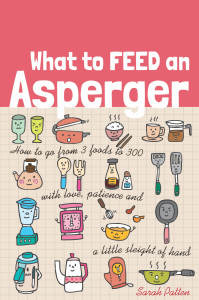Sarah Patten, author of What to Feed an Asperger: How to go from 3 foods to 300 with love, patience and a little sleight of hand, offers her top ten things for parents to consider when feeding a child that has serious sensory issues.
1. Information overload. A child with Asperger Syndrome (ASD) is likely to scrutinize the look, texture, taste and temperature of their food. As parents we need to remember that every feature of what they eat matters.
2. Understand food from your child’s perspective. What looks and smells good to eat? Find ways to get them interested in foods they currently reject but need to eat. Look at ways to engage them that don’t relate directly to taste, for example branching structures got my boy eating broccoli.
3. Just what the doctor ordered. If restricted eating habits are an issue I would advise making a diary of what your child eats for a week and visit your GP to rule out any underlying medical problems that might be making eating unpleasant for them.
4. Can’t touch this! If your child likes food on separate plates – go with it. Graduate to smaller plates, closer together. Then arranged far apart on a bigger plate. Ease into it and foods will be allowed to touch after a while on a regular-sized plate.
5. Give peace a chance. Asperkids can absorb tension like a sponge. Calm mealtimes make for happy eating and digestion. Park arguments and disputes before sitting down and leave those heated ‘discussions’ for later.
6. Are they sitting comfortably? The hardness/softness and ergonomics of a chair need consideration. If a chair doesn’t feel right to your child, they won’t sit still and focus on their food. Memory foam seat wedges worked for us.
7. Get foods past the screen test. Over-analysis and rejection of coloured, multi-textured foods had my Asperger boy eating only breads, cereal and chicken breast. But presenting lamb so it looked like chicken and adding protein rich grains, like quinoa, to bread, did the trick.
8. Creatures of habit. For an Asperger there’s comfort in eating the same food over and over. But set-eating patterns can be altered by introducing other habits that are better for them. We ate a mini broccoli floret at every meal, every day until eating broccoli was a non-issue.
9. Active duty. A sedentary child brimming with antsy-energy is unlikely to eat very well. Getting rid of some of that energy through physical exercise is essential to building up a healthy appetite. Finding some physical activity that they enjoy and cutting the TV screen time will help make them better eaters.
10. You are what you eat. A great diet packed with first class protein, fruit and veggies gives your child the essential minerals and vitamins they need to function and grow. Having Asperger and neurotypical boys I see that diet affects my son with an ASD to a greater degree. Everything about him is turned up to 11, as a family we have adapted and as a result he finds great pleasure in eating different foods now.

Sarah Patten is the author of What to Feed an Asperger: How to go from 3 foods to 300 with love, patience and a little sleight of hand published by Jessica Kingsley Publishers

I would like to bye a copy of this book. Thank you.
Hello Ian
Please go to our website
http://intl.jkp.com/uk/what-to-feed-an-asperger.html
You can purchase a copy there.
Thank you.
My grandson is nine. Only eats chicken nuggets , dry hamburgers , peanut and jelly (school lunch only. ). Disguising food does not help. He can pick out Mc Donald’s nuggets from any other Idont care if the shape is the same or not. He knows. What to do with a child that eats only this. He has stomach issues and has had kidney issues in the past. Nothing seems to work